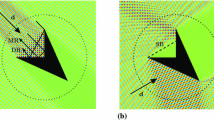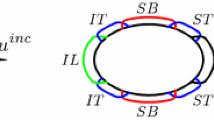Abstract
Time-dependent acoustic scattering problems involving “smart” obstacles are considered. When hit by an incident acoustic field, smart obstacles react in an attempt to pursue a preassigned goal. Let \(\mathbb{R}^3\) be the three-dimensional real Euclidean space, and let \(\Omega \subset \mathbb{R}^3\) be a bounded simply connected open set with a Lipschitz boundary characterized by a constant acoustic boundary impedance χ, immersed in an isotropic and homogeneous medium that fills \(\mathbb{R}^{3}\backslash\Omega\). The closure of Ω will be denoted as \(\overline{\Omega}\). When hit by an incident field, the obstacle Ω pursues the preassigned goal through the action of a control input acting on its boundary (i.e., a quantity with dimensions of a pressure divided by a time). The obstacles considered in this paper monitor the control input acting on their boundaries in order to achieve one of the following goals: (i) be furtive in a given set of the frequency space, and (ii) appear in a given set of the frequency space and outside a given set of \(\mathbb{R}^3\) containing Ω and Ω G as similar as possible to a “ghost” obstacle Ω G having boundary acoustic impedance χ G . It is assumed that \(\overline{\Omega}\cap\overline{\Omega}_G=\emptyset\) and \(\Omega_G \neq \emptyset\). The problem corresponding to the first goal will be called the definite-band furtivity problem, and the problem corresponding to the second goal will be called the definite-band ghost-obstacle problem. These two goals define two classes of smart obstacles. In this paper, these problems are modeled as optimal-control problems for the wave equation introducing a control input acting on the boundary of Ω for time \(t \in \mathbb{R}\). The cost functionals proposed depend on the value of the control input on the boundary of the obstacle and on the value of the scattered acoustic field generated by the obstacle on the boundary in the “furtivity case”, and on the boundary of a suitable set containing Ω and Ω G in the “ghost-obstacle case”. Under some assumptions, the use of the Pontryagin maximum principle allows us to formulate the first-order optimality conditions for the definite-band furtivity problem and for the definite-band ghost-obstacle problem as exterior problems outside the obstacle for a system of two coupled wave equations. Numerical methods to solve these exterior problems are developed by extending previous work. These methods belong to the class of the operator-expansion methods that are highly parallelizable. Numerical experiments proving the validity of the control problems proposed as mathematical models of the definite-band furtivity problem and definite-band ghost obstacle problem are presented. The numerical results obtained with a parallel implementation of the numerical methods developed are discussed and their properties are established. The speed-up factors obtained using parallel computing are really impressive. The website: http://www.econ.univpm.it/recchioni/w11 contains animations and virtual reality applications relative to the numerical experiments.
Similar content being viewed by others
References
Mariani F, Recchioni MC, Zirilli F (2001) The use of the Pontryagin maximum principle in a furtivity problem in time-dependent acoustic obstacle scattering. Waves Random Media 11:549–575
Fatone L, Recchioni MC, Zirilli F (2003) Some control problems for the Maxwell equations related to furtivity and masking problems in electromagnetic obstacle scattering. In: Cohen GC, Heikkola E, Joly P, Neittaanmaki P (eds) Mathematical and numerical aspects of wave propagation. Waves 2003. Springer Verlag, Berlin, pp 189–194
Fatone L, Recchioni MC, Zirilli F (2004) Furtivity and masking problems in time dependent electromagnetic obstacle scattering. J Optimiz Theory Appl 121:223–257
Fatone L, Recchioni MC, Zirilli F (2004) A masking problem in time dependent acoustic obstacle scattering. ARLO – Acoust Res Lett Online 5(2):25–30
Fatone L, Recchioni MC, Zirilli F (2005) Mathematical models of “active” obstacles in acoustic scattering. In: Cagnol J, Zolesio JP (eds) Control and boundary analysis. Lecture notes in pure and applied mathematics vol 240. Marcel Dekker/CRC Press Boca Raton, Fl. USA, pp 119–129
Chambers B (1999) A smart radar absorber. J Smart Mater Struct 8:64–72
Ford KL, Chambers B (2000) A smart microwave absorber. IEE Electron Lett 36:50–52
Chambers B, Tennant A (2002) General analysis of the phase-switched screen Part 1: The single layer case. Proc IEE Part F – Radar Sonar Navig 149:243–247
Chambers B, Tennant A (2002) Influence of switching waveform characteristics on the performance of a single layer phase-switched. IEEE Trans Electromagn Compat 44:434–441
Neçcas J (1967) Les méthodes directes en théorie des équations elliptiques. Masson & Cie. Publ, Paris
Mecocci E, Misici L, Recchioni MC, Zirilli F (2000) A new formalism for time dependent wave scattering from a bounded obstacle. J Acoust Soc Am 107: 1825–1840
Colton D, Kress R (1983) Integral equation methods in scattering theory. J. Wiley & Sons, New York
Knowles G (1981) An introduction to applied control. New York, Academic Press
Lions JL (1971) Optimal control of systems governed by partial differential equations. Springer Verlag, Berlin
Balakrishnan AV (1976) Applied functional analysis. Springer Verlag, New York
Milder DM (1991) An improved formalism for wave scattering from rough surface. J Acoust Soc Amer 89:529–541
Milder DM (1996) Role of the admittance operator in rough-surface scattering. J Acoust Soc Amer 100:759–768
Milder DM (1996) An improved formalism for electromagnetic scattering from a perfectly conducting rough surface. Radio Sci 31:1369–1376
Smith RA (1996) The operator expansion formalism for electromagnetic scattering from rough dielectric surfaces. Radio Sci 31:1377–1385
Milder DM (1998) An improved formulation of coherent forward scatterer from random rough surfaces. Waves Random Media 8:67–78
Piccolo S, Recchioni MC, Zirilli F (1996) The time harmonic electromagnetic field in a disturbed half-space: an existence theorem and a computational method. J Math Phys 37:2762–2786
Misici L, Pacelli G, Zirilli F (1998) A new formalism for wave scattering from a bounded obstacle. J Acoust Soc Amer 103:106–113
Fatone L, Pignotti C, Recchioni MC, Zirilli F (1999) Time harmonic electromagnetic scattering from a bounded obstacle: an existence theorem and a computational methods. J Math Phys 40:4859–4887
Mariani F, Recchioni MC, Zirilli F (2002) A perturbative approach to acoustic scattering from a vibrating bounded obstacle. J Comput Acoust 10:349–384
Mayne DQ, Michalska H (1990) Receding horizon control of nonlinear systems. IEEE Trans Autom Control 35:814–824
Michalska H, Mayne DQ (1993) Robust receding horizon control of constrained nonlinear systems. IEEE Trans Autom Control 38:1623–1633
De Nicolao G, Magni L, Scattolini R (1998) Stabilizing receding-horizon control of nonlinear time-varying systems. IEEE Trans Autom Control 43:1030–1036
Armaou A, Christofides PD (2002) Dynamic optimization of dissipative PDE systems using nonlinear order reduction. Chem Enging Sci 57:5083–5114
Bendersky F, Christofides PD (2000) Optimization of transport-reaction processes using nonlinear model reduction. Chem Enging Sci 55:4349–4366
Recchioni MC, Zirilli F (2003) The use of wavelets in the operator expansion method for time dependent acoustic obstacle scattering. Siam J Sci Comput 25:1158–1186
Pontryagin LS, Boltiamskii VG, Gamkrelidze RV, F (1974) Théorie mathématique des processus optimaux. Editions Mir Moscou
Yosida K (1995) Functional analysis. Springer Verlag, Berlin
Colton D, Kress R (1992) Inverse acoustic and electromagnetic scattering theory. Springer Verlag, Berlin
Author information
Authors and Affiliations
Corresponding author
Rights and permissions
About this article
Cite this article
Fatone, L., Pacelli, G., Recchioni, M.C. et al. Optimal-control methods for two new classes of smart obstacles in time-dependent acoustic scattering. J Eng Math 56, 385–413 (2006). https://doi.org/10.1007/s10665-006-9046-1
Received:
Accepted:
Published:
Issue Date:
DOI: https://doi.org/10.1007/s10665-006-9046-1




